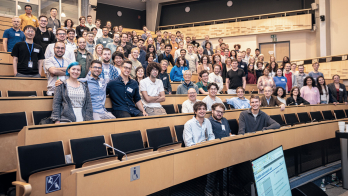
Faced with the no-show of phenomena beyond the Standard Model at the high mass and energy scales explored so far by the LHC, it has recently become a much considered possibility that new physics hides “in plain sight”, namely at mass scales that can be very easily accessed but at very small coupling strengths. If this were the case, then high-intensity experiments have an advantage: thanks to the large number of events that can be generated, even the most feeble couplings corresponding to the rarest processes can be accessible.
Such a high-intensity experiment is NA62 at CERN’s North Area. Designed to measure the ultra-rare kaon decay K → πνν, it has also released several results probing the existence of weakly coupled processes that could become visible in its apparatus, a prominent example being the decay of a kaon into a pion and an axion. But there is also an unusual way in which NA62 can probe this kind of physics using a configuration that was not foreseen when the experiment was planned, for which the first result was recently reported.
During normal NA62 operations, bunches of 400 GeV protons from the SPS are fired onto a beryllium target to generate secondary mesons from which, using an achromat, only particles with a fixed momentum and charge are selected. These particles (among them kaons) are then propagated along a series of magnets and finally arrive at the detector 100 m downstream. In a series of studies starting in 2015, however, NA62 collaborators with the help of phenomenologists began to explore physics models that could be tested if the target was removed and protons were fired directly into a “dump” that can be arranged by moving the achromat collimators. They concluded that various processes exist in which new MeV-scale particles such as dark photons could be produced and detected from their decays into di-lepton final states. The challenge is to keep the muon-induced background under control, which cannot be easily understood from simulations alone.
A breakthrough came in 2018 when beam physicists in the North Area understood how the beamline magnets could be operated in such a way as to vastly reduce the background of both muons and hadrons. Instead of using the two pairs of dipoles as a beam achromat for momentum selection, the currents in the second pair are set to induce additional muon sweeping. The scheme was verified during a 2021 run lasting 10 days, during which 1.4 × 1017 protons were collected on the beam dump. The first analysis of this rapidly collected dataset – a search for dark photons decaying to a di-muon final state – has now been performed.
Hypothesised to mediate a new gauge force, dark photons, A′, could couple to the Standard Model via mixing with ordinary photons. In the modified NA62 set-up, dark photons could be produced either via bremsstrahlung or decays of secondary mesons, the mechanisms differing in their cross-sections and distributions of the momenta and angles of the A′. No sign of A′ → μ+μ– was found, excluding a region of parameter space for dark-photon masses between 215 and 550 MeV at 90% confidence. A preliminary result for a search for A′ → e+e– was also presented at the Rencontres de Moriond in March.
“This result is a milestone,” explains analysis leader Tommaso Spadaro of LNF Frascati. “It proves the capability of NA62 for studying physics in the beam-dump configuration and paves the way for upcoming analyses checking other final states.”
Further reading
NA62 Collab. 2023 arXiv:2303.08666.







